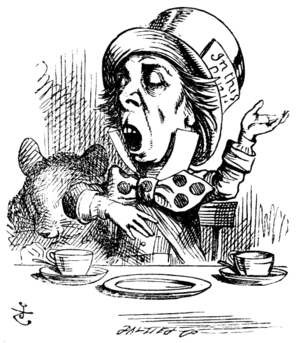Lewis Carroll’s character the Mad Hatter is perhaps one of the most memorable characters in “Alice’s Adventures in Wonderland.” The book has been around since the mid 1800s, and the scene that takes place at the mad tea-party (which introduced the hatter and included other characters such as the March Hare who were mad) is one of the things that everyone remembers about the story. However the idea of a mad hatter wasn’t new, and it came from the commonly used phrase “mad as a hatter.” However, like other things we take for granted like how a blue moon means a long time, that stuffed bears are called Teddy Bears and even the names of the days of the week, most people don’t really appreciate what this term means.
During the Victorian Era (which is almost congruent with the hey day of the Wild West and the Civil War for those paying attention) felt hats became quite popular. Bowlers, top hats and other examples were a fashion requirement if one was going to be accepted in normal society; men wore hats and that’s the way it was. As such there was an entire industry producing hats, from beaver fur as well as from lower quality rabbit fur. For the lower quality fur mercury dust was brushed over the hide during the tanning process as a cheap way of making it easier to work with. Of course we now know that mercury is a heavy metal, that it’s poisonous and that exposure to it over time is extremely hazardous if you don’t wear proper safety equipment which had not been invented at the time being discussed. As such those who made hats were exposed to mercury a lot; in the fur, the glue, the hat bands and pretty much everything else.
If you absorb a great deal of mercury into your system you begin to display symptoms like jerkiness and twitching, loosening of teeth, loss of coordination, slurred speech, loss of memory, mood swings, depression and anxiety. These symptoms, often referred to as Mad Hatter’s disease or Hatter’s Shakes, were sometimes confused with schizophrenia, a condition where due to blank affect, delusions and other problems communicating with the schizophrenic can be problematic. Though medical science wasn’t at a great point, we have since come forward enough to realize that this heavy metal, which we used to use in dental fillings, thermometers and even as a fun experiment in science class, was likely the reason for these strange behaviors as hatters had their kidneys, lungs and nervous systems polluted by the constant exposure to the chemicals of their craft.
As Mad As a Hatter,” by Anonymous at Phrases
“Mad As a Hatter,” by Anonymous at World Wide Words
“What Caused the Mad Hatter to go Mad?” by Dex at The Straight Dope





